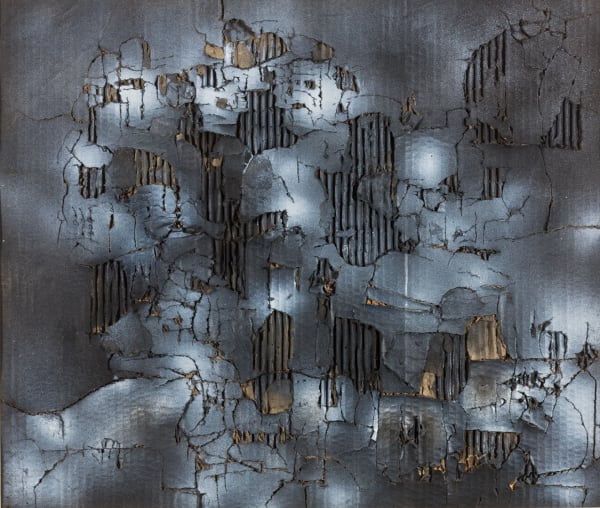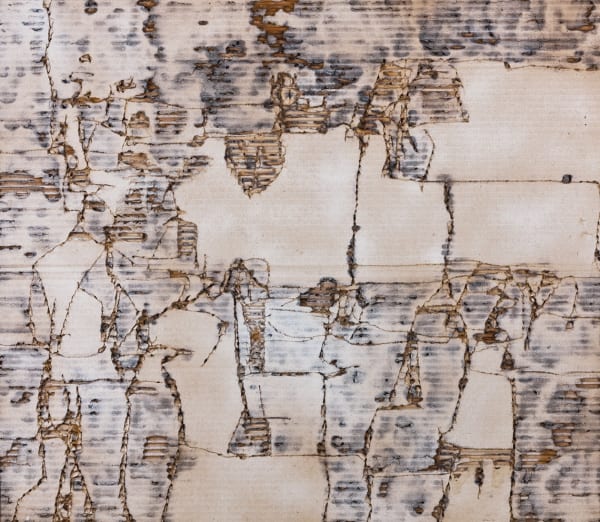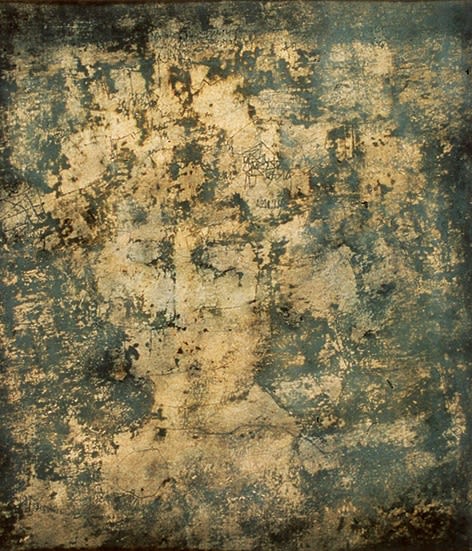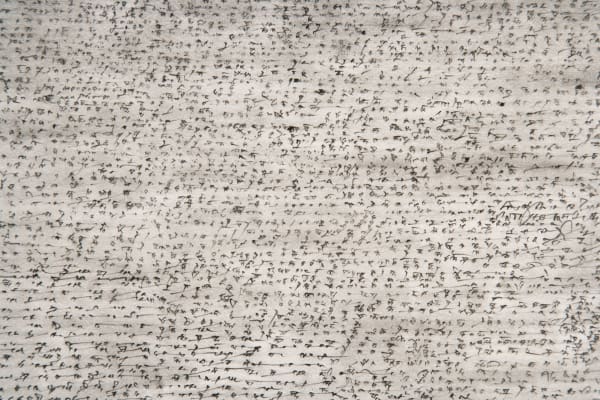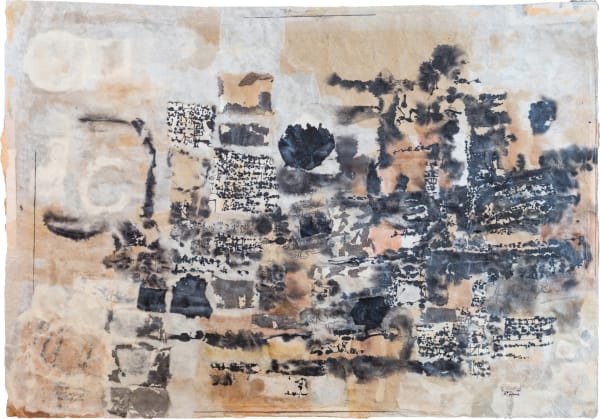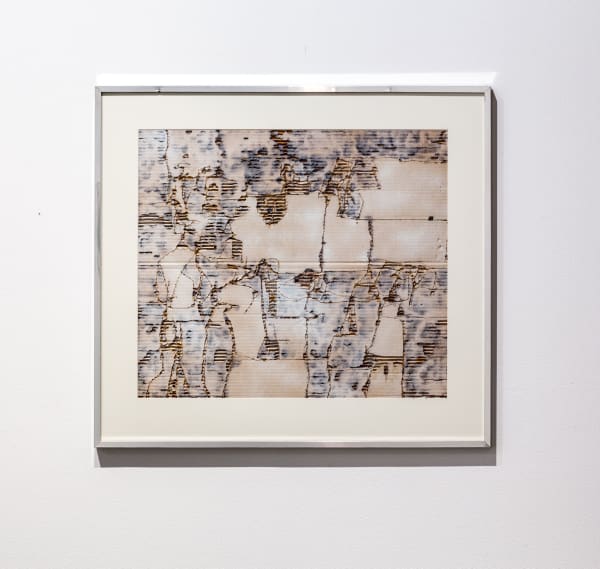Maliheh Afnan 1935-2016
Maliheh Afnan works with paper on an intimate scale to create works of refined beauty. Inspired by predominantly archeology and script, her works allude to ancient scrolls and tablets. Yet, at other times, her abstract works appear as landscapes, figures or relics that have been excavated from a long-forgotten site. Using muted hues and earthy colors, her mesmerizing layers and overlapping patterns leave a sense of what it means to live in other times and in different places. Although influenced by the traditional art forms of her own heritage (Persian miniatures, calligraphic texts and ancient manuscripts from the Near East) her Western education has caused her to looks towards artists such as Klee, Rothko and Pollock. In this regard her work absorbs and transcends any direct cultural references creating her own unique language.
Maliheh Afnan was born in 1935 to Persian parents in Haifa, Palestine, where she lived until 1949. Her family then moved to Beirut, where she went to high school and later graduated with a BA from the American University of Beirut in 1955. In 1956 she moved to Washington DC, where she graduated with an MA in Fine Arts at the Corcoran School of Art (1962). From 1963-66 she lived in Kuwait and then returned to Beirut, where she lived until 1974. She spent the following 23 years in Paris, where she had numerous exhibitions, before settling in London in 1997.
Afnan's most recent solo exhibition was her retrospective Personnages, at Man Museo D'arte Provincia Di Nuoro, Sardinia, 2019 curated by Luigi Fassi.
Previous to that she presented Tracing Memories, Art Dubai Modern, 2016; Speak Memory, Rose Issa Projects, London, 2013; Traces, Faces, Places, Rose Issa Projects, London, 2010; Selected Works, England and Co, London, 2006; Maliheh Afnan: Retrospective, England and Co, London, 2000; and And Presented by Mark Tobey, Galerie Claire Brambach, Basel, Switzerland, 1971. She has also exhibited at Galerie Mouvances, Paris, 1996; Théâtre de Beyrouth, Beirut, 1994; Galerie 10 Bonaparte, Paris, 1994; Galerie Arcadia, Paris, 1987; A&A Turner Galerie, Paris, 1982; Galerie Brigitte Schehadé, Paris and Galerie Principe-Anne Merlet, Paris,1978.
Select group shows include Asemic, Cultuurcentrum Brugge, Brugge, 2014; The Blue Route: Journeys and Beauty from the Mediterranean to China, Boghossian Foundation, Brussels, 2013; Hope Map, Cuulturcentrum, Bruges, 2013; The Art of Writing, Kurhaus Kolonnade, Wiesbaden, 2011; Zendegi: Twelve Contemporary Iranian Artists , Beirut Exhibition Center, Beirut, 2011; Miragens, touring exhibition at the Centro Cultural Banco do Brasil, Rio de Janeiro, Sao Paulo and Brasilia, Brazil, 2011; Modern Times – Responding to Chaos, Kettle’s Yard, Cambridge and De La Warr Pavilion, Bexhill-On-Sea, UK, 2010; Taswir: Pictorial Mappings of Islam and Modernity, Martin-Gropius-Bau Museum, Berlin, 2009; Re-Orientations: Contemporary Arab Representations, European Parliament, Brussels, 2008; Routes, Waterhouse & Dodd, London, 2008; Word into Art, Dubai, 2008; The Dance of Pen and Ink, The State Museum of Oriental Art, Moscow and The State Hermitage Museum, St Petersburg, 2007; Routes, the British Museum, London,2006; Iranian Contemporary Art, Curve Gallery, Barbican Centre, London, 2001; Salon d’Automne, Thorigny-Sur-Marne, France, 1994; Collecting 20th-Century Art, The British Museum, London, 1991; and Painting and Sculpture at the End of the 20th Century, European Cultural Centre of Delphi, 1988.
Afnan’s work is in several public collections, including the Written Art Collection, Germany; The Metropolitan Museum, New York; The British Museum, London; the Institut du Monde Arabe, and the Barjeel Art Collection, Sharjah.
She has also featured in several publications, most recently Familiar Faces (2013, Rose Issa Projects) and Maliheh Afnan: Traces, Faces, Places (2010, Al Saqi Books & Beyond Art Productions).
Maliheh Afnan passed away in London in January 2016.
-

TAKING SHAPE: ABSTRACTION FROM THE ARAB WORLD, 1950S – 1980S
Mohamed Melehi and Maliheh Afnan at the Block Museum of Art, United States 22 Sep - 4 Dec 2022 MuseumsBlock Museum of Art, Northwestern University will present Taking Shape: Abstraction from the Arab World, 1950s–1980s, a groundbreaking exhibition drawn from the collection of the Barjeel Art Foundation based in...Read more -

The Symmetry of Fragility
Maliheh Afnan at Massimo de Carlo for Fondazione ICA Milano 23 Jun - 5 Jul 2020Fondazione ICA Milano presents La simmetria della fragilità / The symmetry of fragility - a virtual group exhibition curated by Alberto Salvadori and Luigi Fassi, featuring a selection of works...Read more -

Materialize
Maliheh Afnan, Farhad Ahrarnia, Shaikha Al Mazrou, Asad Faulwell, Fathi Hassan, Mohamed Ahmed Ibrahim, Nadia Kaabi-Linke, Mona Saudi, Driss Ouadahi, Shahpour Pouyan 18 Mar - 7 Apr 2019 GalleryOpening 18 March in Warehouse 13 -a large space just across from its gallery within Alserkal Avenue- Lawrie Shabibi presents a major group exhibition to coincide with the 12th edition...Read more
-

Harper's Bazaar Art Arabia Features Maliheh Afnan
Asmaa Al-Shabibi, Harper's Bazaar Art Arabia, May 19, 2016 -

Selections Magazine Reviews Maliheh Afnan's Exhibition at Art Dubai Modern
Laura Egerton, Selections , May 1, 2016 -

Art Dubai Modern Turns the Tables on Gender Stereotyping in the Middle East
Danna Lorch, Artslant, March 16, 2016 -

Maliheh Afnan in Harper's Bazaar Art Arabia Preview of Art Dubai Modern, 2016
Art Dubai, Harper's Bazaar Art Arabia, March 1, 2016

